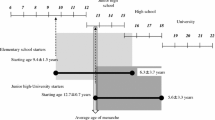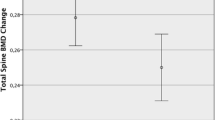Abstract
Summary
This study investigated the long-term relationship between the exposure to childhood recreational gymnastics and bone measures and bone strength parameters at the radius and tibia. It was observed that individuals exposed to recreational gymnastics had significantly greater total bone content and area at the distal radius. No differences were observed at the tibia.
Introduction
This study investigated the relationship between exposure to early childhood recreational gymnastics with bone measures and bone strength development at the radius and tibia.
Methods
One hundred twenty seven children (59 male, 68 female) involved in either recreational gymnastics (gymnasts) or other recreational sports (non-gymnasts) between 4 and 6 years of age were recruited. Peripheral quantitative computed tomography (pQCT) scans of their distal and shaft sites of the forearm and leg were obtained over 3 years, covering the ages of 4–12 years at study completion. Multilevel random effects models were constructed to assess differences in the development of bone measures and bone strength measures between those exposed and not exposed to gymnastics while controlling for age, limb length, weight, physical activity, muscle area, sex, and hours of training.
Results
Once age, limb length, weight, muscle area, physical activity, sex, and hours of training effects were controlled, it was observed that individuals exposed to recreational gymnastics had significantly greater total bone area (18.0 ± 7.5 mm2) and total bone content (6.0 ± 3.0 mg/mm) at the distal radius (p < 0.05). This represents an 8–21 % benefit in ToA and 8–15 % benefit to ToC from 4 to 12 years of age. Exposure to recreational gymnastics had no significant effect on bone measures at the radius shaft or at the tibia (p > 0.05).
Conclusions
Exposure to early life recreational gymnastics provides skeletal benefits to distal radius bone content and area. Thus, childhood recreational gymnastics exposure may be advantageous to bone development at the wrist.



Similar content being viewed by others
References
Bonjour JP, Chevalley T, Ferrari S, Rizzoli R (2009) The importance and relevance of peak bone mass in the prevalence of osteoporosis. Salud Publica Mex 51(Suppl 1):S5–S17
Baxter-Jones AD, McKay H, Burrows M, Bachrach LK, Lloyd T, Petit M et al (2010) International longitudinal paediatric reference standards for bone mineral content. Bone 46:208–216
Bailey DA (1997) The Saskatchewan pediatric bone mineral accrual study: bone mineral acquisition during the growing years. Int J Sports Med 18(Suppl 3):S191–S194
Khan KM, McKay HA, Kannus P, Bailey DA, Wark J, Bennell KL (2001) Physical activity and bone health. Human Kinetics, Champaign
Bass SL (2000) The prepubertal years: a uniquely opportune stage of growth when the skeleton is most responsive to exercise? Sports Med 30:73–78
Nikander R, Sievanen H, Uusi-Rasi K, Heinonen A, Kannus P (2006) Loading modalities and bone structures at non weight-bearing upper extremity and weight-bearing lower extremity: a pQCT study of adult female athletes. Bone 39:886–894
Turner CH, Robling AG (2003) Designing exercise regimens to increase bone strength. Exerc Sport Sci Rev 31:45–50
Bass S, Pearce G, Bradney M, Hendrich E, Delmas PD, Harding A et al (1998) Exercise before puberty may confer residual benefits in bone density in adulthood: studies in active prepubertal and retired female gymnasts. J Bone Miner Res 13:500–507
Daly RM, Rich PA, Klein R, Bass S (1999) Effects of high-impact exercise on ultrasonic and biochemical indices of skeletal status: a prospective study in young male gymnasts. J Bone Miner Res 14:1222–1230
Dowthwaite JN, Rosenbaum PF, Scerpella TA (2012) Site-specific advantages in skeletal geometry and strength at the proximal femur and forearm in young female gymnasts. Bone 50:1173–1183
Erlandson MC, Kontulainen SA, Chilibeck PD, Arnold CM, Baxter-Jones AD (2011) Bone mineral accrual in 4- to 10-year-old precompetitive, recreational gymnasts: a 4-year longitudinal study. J Bone Miner Res 26:1313–1320
Erlandson MC, Kontulainen SA, Baxter-Jones AD (2011) Precompetitive and recreational gymnasts have greater bone density, mass, and estimated strength at the distal radius in young childhood. Osteoporos Int 22:75–84
Faulkner RA, Forwood MR, Beck TJ, Mafukidze JC, Russell K, Wallace W (2003) Strength indices of the proximal femur and shaft in prepubertal female gymnasts. Med Sci Sports Exerc 35:513–518
Gruodyte-Raciene R, Erlandson MC, Jackowski SA, Baxter-Jones AD (2013) Structural strength development at the proximal femur in 4- to 10-year-old precompetitive gymnasts: a 4-year longitudinal hip structural analysis study. J Bone Miner Res 28:2592–6000
Ducher G, Hill BL, Angeli T, Bass SL, Eser P (2009) Comparison of pQCT parameters between ulna and radius in retired elite gymnasts: the skeletal benefits associated with long-term gymnastics are bone- and site-specific. J Musculoskelet Neuronal Interact 9:247–255
Erlandson M, Kontulainen S, Chilibeck P, Arnold C, Faulkner R, Baxter-Jones A (2012) Higher premenarcheal bone mass in elite gymnasts is maintained into young adulthood after long-term retirement from sport: a 14-year follow-up. J Bone Miner Res 27:104–110
Eser P, Hill B, Ducher G, Bass S (2009) Skeletal benefits after long-term retirement in former elite female gymnasts. J Bone Miner Res 24:1981–1988
Kudlac J, Nichols DL, Sanborn CF, DiMarco NM (2004) Impact of detraining on bone loss in former collegiate female gymnasts. Calcif Tissue Int 75:482–487
Pollock NK, Laing EM, Modlesky CM, O’Connor PJ, Lewis RD (2006) Former college artistic gymnasts maintain higher BMD: a nine-year follow-up. Osteoporos Int 17:1691–1697
Burt LA, Greene DA, Ducher G, Naughton GA (2013) Skeletal adaptations associated with pre-pubertal gymnastics participation as determined by DXA and pQCT: a systematic review and meta-analysis. J Sci Med Sport 16:231–239
International standards for anthropometric assessment (2001) International Society for the Advancement of Kinanthropometry, Sydney, Australia
Kontulainen SA, Johnston JD, Lui D, Leung C, Oxland TR, McKay HA (2008) Strength indices from pQCT imaging predict up to 85% of variance in bone failure properties at the tibial epiphysis and diaphysis. J Musculoskelet Neuronal Interact 8:401–409
Duckham RL, Frank AW, Johnston JD, Olyszynski WP, Kontulainen SA (2013) Monitoring time interval for pQCT-derived bone outcomes in postmenopausal women. Osteoporos Int 24:1917–1922
Janz KF, Broffitt B, Levy SM (2005) Validation evidence for The Netherlands physical activity questionnaire for young children: the Iowa bone development study. Res Q Exerc Sport 76:363–369
Whiting SJ, Shrestha R (1993) Dietary assessment of elementary school aged children and adolescents. J Can Diet Assoc 54:193–196
Goldstein H, Browne W, Rasbash J (2002) Multilevel modeling of medical data. Stat Med 21:3291–3315
Baxter-Jones A, Mirwald RL (2004) Multilevel modeling. In: Hauspie RC, Cameron N, Molinari L (eds) Methods in human growth research. Cambridge University Press, Cambridge, pp 306–330
Bailey DA, McKay HA, Mirwald RL, Crocker PR, Faulkner RA (1999) A six-year longitudinal study of the relationship of physical activity to bone mineral accrual in growing children: the University of Saskatchewan bone mineral accrual study. J Bone Miner Res 14:1672–1679
Baxter-Jones AD, Kontulainen SA, Faulkner RA, Bailey DA (2008) A longitudinal study of the relationship of physical activity to bone mineral accrual from adolescence to young adulthood. Bone 43:1101–1107
Nickols-Richardson SM, Modlesky CM, O’Connor PJ, Lewis RD (2000) Premenarcheal gymnasts possess higher bone mineral density than controls. Med Sci Sports Exerc 32:63–69
Laing EM, Wilson AR, Modlesky CM, O’Connor PJ, Hall DB, Lewis RD (2005) Initial years of recreational artistic gymnastics training improves lumbar spine bone mineral accrual in 4- to 8-year-old females. J Bone Miner Res 20:509–519
Adami S, Gatti D, Braga V, Bianchini D, Rossini M (1999) Site-specific effects of strength training on bone structure and geometry of ultradistal radius in postmenopausal women. J Bone Miner Res 14:120–124
Robling AG, Castillo AB, Turner CH (2006) Biomechanical and molecular regulation of bone remodeling. Annu Rev Biomed Eng 8:455–498
Binkley TL, Specker BL (2000) pQCT measurement of bone parameters in young children: validation of technique. J Clin Densitom 3:9–14
Hangartner TN, Gilsanz V (1996) Evaluation of cortical bone by computed tomography. J Bone Miner Res 11(10):1518–1525
Lyons RA, Delahunty AM, Kraus D, Heaven M, McCabe M, Allen H et al (1999) Children’s fractures: a population based study. Inj Prev 5:129–132
Primavesi R (2011) Sticks and stones and broken bones: distal radius fractures in children. Can Fam Physician 57:45–46
de Putter CE, van Beeck EF, Looman CW, Toet H, Hovius SE, Selles RW (2011) Trends in wrist fractures in children and adolescents, 1997–2009. J Hand Surg [Am] 36:1810–1815
Farr JN, Going SB (2014) Active voice: Physical activity, skeletal muscle, and bone interactions during growth. Sports Medicine Bulletin. http://multibriefs.com/briefs/acsm/ACSM010714.php. Accessed 7 Jan 2014
Ward KA, Roberts SA, Adams JE, Mughal MZ (2005) Bone geometry and density in the skeleton of pre-pubertal gymnasts and school children. Bone 36:1012–1018
Acknowledgments
We acknowledge all the study participants and their families for their constant enthusiasm and commitment to this project. We thank Dominika Pindus, Juliegh Clarke, Megan Labas, Joelle Schaefer, and Emma Burke for assistance in data collection and nutrition and pQCT data analysis. This study was supported in part by funding from the Canadian Institutes of Health Research (CIHR; MOP 57671 and MOP 98002), the Canadian Foundation for Innovation, and The Saskatchewan Health Research Foundation (SHRF). RGR received funding through the SHRF post-doctoral fellowship.
Authors’ roles
Study design: ME and ABJ. Data collection: ME, RGR, SJ. Data analysis: SJ, ABJ, SK, RGR and ME. Data interpretation: SJ, ME, RGR, SK and ABJ. Drafting and revising manuscript: SJ, ABJ, RGR, SK and ME. All authors approved the final version of this manuscript.
Conflicts of interest
Stefan Jackowski, Adam Baxter-Jones, Rita Gruodyte-Raciene, Saija Kontulainen, and Marta Erlandson declare that they have no conflicts of interest.
Author information
Authors and Affiliations
Corresponding author
Rights and permissions
About this article
Cite this article
Jackowski, S.A., Baxter-Jones, A.D.G., Gruodyte-Raciene, R. et al. A longitudinal study of bone area, content, density, and strength development at the radius and tibia in children 4–12 years of age exposed to recreational gymnastics. Osteoporos Int 26, 1677–1690 (2015). https://doi.org/10.1007/s00198-015-3041-1
Received:
Accepted:
Published:
Issue Date:
DOI: https://doi.org/10.1007/s00198-015-3041-1




